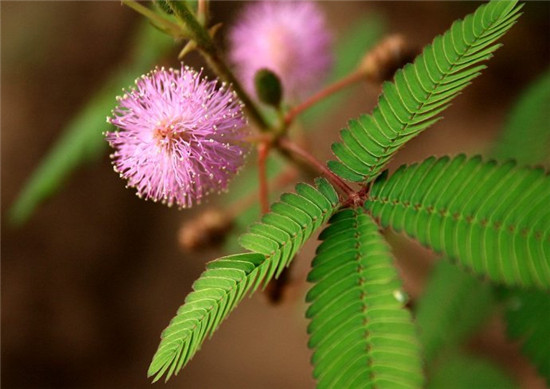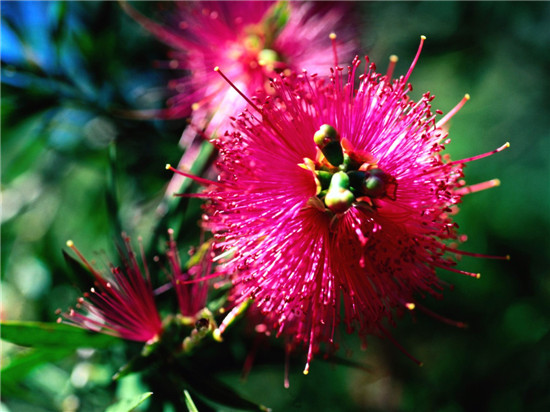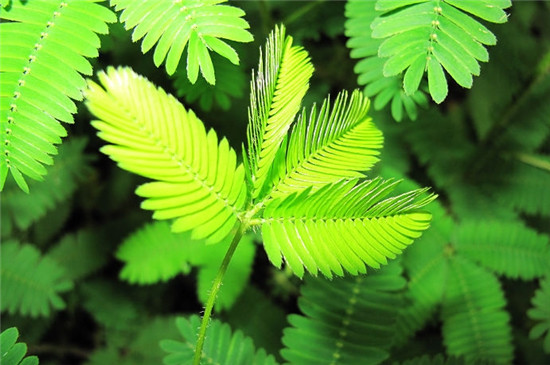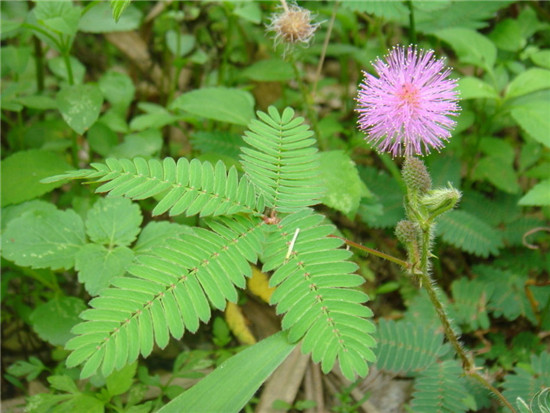[the function of mimosa] the characteristics and functions of mimosa
Mimosa, also known as mimosa, its leaves are very sensitive, such a reaction makes many people find it interesting, so they think they might as well raise one. Next, let's take a look at the characteristics and functions of mimosa.

Mimosa is a perennial herb or subshrub of Leguminosae, which is named mimosa because its leaves respond to heat and light and close immediately when touched by external forces. Shaped like a fluffy ball. Pods bear fruit after flowering, and the fruit is flat and round. The leaves are feathery and compound leaves are alternate and arranged in palms. Flowering about after the height of summer, heads oblong, 2-3 in leaf axils. The flowers are white and pink, with a bell-shaped calyx, 8 tiny calyx teeth and four-lobed petals, which are the characteristics of a simple mimosa.
The leaves of mimosa have quite long petioles, and the front end of the stalk is divided into four pinnae, each with two rows of long oval pinnae, the total stalk is very long, and the base expands into a leaf pillow, that is, there is a fat part at the base of the pinna, pinnacle and petiole of mimosa, which is called leaf pillow.

The leaves are pinnately compound, with 2-4 pinnae, palmately arranged, 14-48 leaflets, oblong, 0.6-1.1 cm long and 1.5-2 mm wide, with spiny edges and veins. Flowering about after the height of summer, heads oblong, 2-3 in leaf axils. Flowers reddish, calyx campanulate, with 8 tiny calyx teeth, petals quadrifid, stamens 4, ovary glabrous.
The pod is flat, 1.2-2 cm long and 0.4 cm wide, with bristles on the margin, 3-4 pod nodes, 1 seed per pod node and shedding at internodes at maturity. The florescence is September.
In addition to the above characteristics of mimosa, mimosa is also reflected in medical treatment, the whole grass (including mimosa) sweet, astringent, cool. Calming the mind, clearing heat and detoxification. For vomiting and diarrhea, insomnia, infantile accumulation, eye swelling and pain, deep abscess, banded vesicular rash. Root (including mimosa root): astringent, slightly bitter. poisonous. Relieving cough and resolving phlegm, promoting dampness and dredging collaterals, harmonizing the stomach and eliminating accumulation. For cough, phlegm and asthma, rheumatic arthralgia, infantile indigestion. You can also give mimosa to friends, gently cover the potted plants with pink tulle and tie them with pink ribbons and rosettes. It would be more interesting if you could adorn it with pink mohair balls.

The function of mimosa
1. Mimosa can predict the weather.
Mimosa is a wonderful plant that can predict changes in the weather. If you touch it with your hand, its leaves close quickly and open slowly, indicating that the weather will clear up; if you touch mimosa, its leaves contract slowly, droop slowly, or even reopen a little bit, this means that the weather will change from sunny to overcast or it is going to rain.
2. It can also predict earthquakes.
Mimosa can predict earthquakes. According to Turkish seismologist Erjiang, a few hours before a strong earthquake, the leaves of mimosa, which are sensitive to the outside world, suddenly shrink and then wither. In earthquake-prone Japan, scientists have found that under normal circumstances, mimosa leaves open during the day and close at night. If the leaves of mimosa close during the day and open at night, it is a sign of an earthquake. For example, at 7: 00 a.m. on January 11, 1938, the mimosa began to open, but at 10:00, all the leaves suddenly closed, and sure enough, a strong earthquake occurred on the 13th. Members of the earthquake Club of Japan in 1976 observed the abnormal closure of mimosa leaves many times, resulting in an earthquake.

3. It has a special ornamental function.
Mimosa plant shape scattered, feather leaves slender and beautiful, its leaves are closed at a touch; mimosa flowers are many and beautiful, charming, giving people the impression of weak and elegant. It can be planted in the corner of the courtyard or potted in the window. When giving flowers, gently cover the potted plants with pink tulle and tie them with pink ribbons and knots. It would be more interesting if you could adorn it with pink mohair balls.
4. The medicinal value of mimosa is not cheap.
Mimosa is also a medicine. Summer and autumn harvest, to clean weeds, wash, cut, dry or fresh use. Taking or frying mimosa root with wine can treat rheumatism, neurasthenia, insomnia, etc., and stew with lean pork can treat eye fever, swelling, hepatitis and nephritis. The fresh products of leaves can be mashed, can be applied to treat swelling and pain and herpes zoster, quite effective in relieving pain and swelling, clearing heat and diuresis, resolving phlegm and cough, relieving pain, detoxification, removing blood stasis, hemostasis, convergence and other effects, for colds, children with high fever, acute conjunctivitis, bronchitis, gastritis, enteritis, urinary calculi, malaria, neurasthenia; external treatment of swelling and pain, sores, hemoptysis, herpes zoster.
The above is the whole content of the characteristics and functions of mimosa that I have summarized for you. I hope this article can help you. Please continue to follow us.
It has the effects of relieving pain, detoxification, removing blood stasis, hemostasis, convergence, etc., for colds, high fever in children, acute conjunctivitis, bronchitis, gastritis, enteritis, urinary calculi, malaria, neurasthenia; external use to treat swelling and pain, sores, swelling, hemoptysis, herpes zoster.
The above is the whole content of the characteristics and functions of mimosa that I have summarized for you. I hope this article can help you. Please continue to follow us.
Related
- Wuhan Hospital Iron Tree Blooming Result Was Instantly Frightened by the Gardener Master
- Which variety of camellia is the most fragrant and best? Which one do you like best?
- What is the small blue coat, the breeding methods and matters needing attention of the succulent plant
- Dormancy time and maintenance management of succulent plants during dormancy
- Minas succulent how to raise, Minas succulent plant pictures
- What are the varieties of winter succulent plants
- How to raise succulent plants in twelve rolls? let's take a look at some experience of breeding twelve rolls.
- Attention should be paid to water control for succulent plants during dormant period (winter and summer)
- Watering experience of twelve rolls of succulent plants
- Techniques for fertilizing succulent plants. An article will let you know how to fertilize succulent plants.



